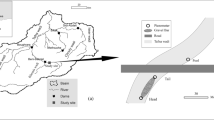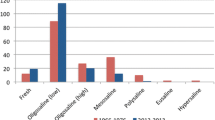Abstract
Interstitial water samples were collected from two well depths (30 and 60 cm) from 8 rivers in the Cass-Craigieburn region, South Island (New Zealand) during January 1998 to assess the hyporheos in streams of differing stability. Hyporheic water chemistry was more similar to surface water chemistry at unstable sites than at stable sites. The greatest diversity of both epigean and hypogean animals occurred at intermediate levels of disturbance; however, invertebrate density declined with increasing bed movement. Abundance of epigean animals also increased with declining environmental stability (i.e., increasing bed movement). Water chemistry was most like the river channel at unstable sites, probably because less stable substrates had increased interstitial flow facilitating a greater supply of water from the surface channel. In contrast, stable sites were spring fed and groundwater had a greater influence. Thus, substrate stability may influence hyporheic water chemistry and porosity by changing the interaction between ground and surface waters. Epigean taxa may be less abundant at stable sites because the chemical nature of the water is least like the river channel (e.g. low dissolved oxygen, higher temperature and higher conductivity), while the abundance of hypogean animals is greater, as these taxa are more tolerant of this water chemistry, and are thus capable of persisting in the stable substrates.
Similar content being viewed by others
References
Berry, K. J., K. L. Kvamme & P. W. J. Mielke, 1983. Improvements in the permutation test for spatial analysis of distribution of artifacts into classes. Am. Antiquity 48: 547–553. 94
Biondini, M. E., C. D. Bonham & E. F. Redente, 1985. Secondary successional patterns in a sagebrush (Artemesia tridentata) community as they relate to soil disturbance and soil biological activity. Vegetatio 60: 25–36.
Boulton, A. J., 1989. Over-summer refuges of macroinvertebrates in two intermittent streams in Central Victoria. Trans. R. Soc. Aust. 113: 23–34.
Boulton, A. J., S. Findlay, P. Marmonier, E. H. Stanley & H. M. Valett, 1998. The functional significance of the hyporheic zone in streams and rivers. Ann. Rev. Ecol. Syst. 29: 59–81.
Boulton, A. J., H. M. Valett & S. G. Fisher, 1992. Spatial distribution and taxonomic composition of the hyporheos of several Sonoran Desert streams. Archiv für Hydrobiol. 125: 37–61.
Brunke, M. & T. Gosner, 1999. Hyporheic invertebrates-the clinical nature of interstitial communities structured by hydrological exchange and environmental gradients. J. n. amer. Benthol. Soc. 18: 344–362.
Chapman, A. & M. Lewis, 1976. An Introduction to the Freshwater Crustacea of New Zealand. Collins, Auckland, New Zealand.
Clifford, H. T. & W. Stevenson, 1975. An Introduction to Numerical Classification. Academic Press, London, England.
Connell, J. H., 1978. Diversity in tropical rainforests and coral reefs. Science 199: 1302–1310.
Cooling, M. P. & A. J. Boulton, 1993. Aspects of the hyporheic zone below the terminus of a South Australian Arid-zone Stream. Aust. J. mar. Freshwat. Res. 44: 411–426.
Danielopol, D. L., 1989. Groundwater fauna associated with riverine aquifers. J. n. amer. Benthol. Soc. 8: 18–35.
Death, R. G., 1991. Environmental Stability: its effects on stream benthic communities. PhD. Canterbury, Christchurch, New Zealand.
Death, R. G. & M. J. Winterbourn, 1994. Environmental stability and community persistence: a multivariate perspective. J. n. amer. Benthol. Soc. 13: 125–139.
Death, R. G. & M. J. Winterbourn, 1995. Diversity patterns in stream benthic invertebrate communities: the influence of habitat stability. Ecology 76: 1446–1460.
Dole-Oliver, M. J. & P. Marmonier, 1992. Patch distribution of interstitial communities: prevailing factors. Freshwat. Biol. 27: 177–191.
Dole-Oliver, M. J., P. Marmonier & J. L. Beffy, 1997. Response of invertebrates to lotic disturbance: is the hyporheic zone a patchy refugium? Freshwat. Biol. 37: 257–276.
Downes, B. J., P. S. Lake, A. Glaister & J. A. Webb, 1998. Scales and frequencies of disturbances: rock size, bed packing and variation among upland streams. Freshwat. Biol. 40: 625–639.
Grime, J. P., 1973. Control of species density in herbaceous vegetation. J. Envir. Manage. 1: 151–167.
Grimm, N. B. & S. G. Fisher, 1984. Exchange between interstitial and surface water: implications for stream metabolism and nutrient cycling. Hydrobiologia 111: 219–228.
Haschenburger, J. K. & M. Church, 1998. Bed material transport estimated for the virtual velocity of sediment. Earth Surface Processes and landform 23: 781–808.
Hildrew, A. G. & P. S. Giller, 1994. Patchiness, species interactions and disturbance in the stream benthos. Blackwell Scientific Publishers.
Kochel, R. C., 1988. Geomorphic impact of large floods: review and new perspectives on magnitude and frequency. In Baker V. R., R. C. Kochel & P. C. Patton (eds), Flood Geomorphology. John Wiley and Sons, New York, U.S.A.: 169–187.
Komar, P. D., 1988. Sediment transport by floods. In Baker V. R., R. C. Kochel & P. C. Patton, (eds), Flood Geomorphology. John Wiley and Sons, New York, U.S.A.: 97–111.
Lancaster, J., 1999. Small-scale movements of lotic macroinvertebrates with variations in flow. Freshwat. Biol. 41: 605–619.
Mackay, R. J., 1992. Colonisation by lotic macro-invertebrates: a review of processes and patterns. Can. J. Fish. aquat. Sci. 49: 617–628.
Marmonier, P. & M. C. D. Châtelliers, 1991. Effects of spates on interstitial assemblages of the Rhône River. Importance of spatial heterogeneity. Hydrobiologia 210: 243–251.
Matthaei, C. D., K. A. Peacock & C. R. Townsend, 1999. Scour and fill patterns in a New Zealand stream and potential implications for invertebrate refugia. Freshwat. Biol. 42: 41–57.
Matthaei, C. D., U. Uehlinger & A. Frutiger, 1997. Response of benthic invertebrates to natural versus experimental disturbance in a Swiss prealpine river. Freshwat. Biol. 37: 61–77.
McCune, B. & M. J. Mefford, 1995. PC-ORD. Multivariate analysis of ecological data. In MjM Software Design, Gleneden Beach, Oregon, U.S.A.
Palmer, M. A., P. Arensburger, A. P. Martin & D.W. Denman, 1996. Disturbance and patch-specific responses: the interactive effects of woody debris and floods on lotic invertebrates. Oecologia 105: 247–257.
Palmer, M. A., A. E. Bely & K. E. Berg, 1992. Response of invertebrates to lotic disturbance: a test of the hyporheic refuge hypothesis. Oecologia 89: 182–194.
Resh, V. H., A. V. Brown, A. P. Covich, M. E. Gurtz, H. W. Li, G. W. Minshall, S. R. Reice, A. L. Sheldon, J. B. Wallace & R. Wissmar, 1988. The role of disturbance in stream ecology. J. n. am. Benthol. Soc. 7: 433–455.
Richards, C. & K. L. Bacon, 1994. Influence of fine sediment on macroinvertebrate colonisation of surface and hyporheic stream substrates. Great Basin Nat. 54: 106–113.
Robinson, C. T. & G. W. Minshall, 1986. Effects of disturbance frequency on stream benthic community structure in relation to canopy cover and season. J. n. amer. Benthol. Soc. 5: 237–248.
Sagar, P. M., 1983. Invertebrate recolonisation of previously dry channels in the Rakaia River. New Zealand J.mar. Freshwat. Res. 17: 377–386.
Schwoerbel, J., 1961. Uber die Lebensbedingungen und die Besiedlung hyporheischen Lebensraumes. Archiv für Hydrobiol. 25: 182–214.
Scrimgeour, G. J. & M. J. Winterbourn, 1989. Effects of floods on epilithon and benthic macroinvertebrate populations in an unstable New Zealand river. Hydrobiologia 171: 33–44.
Sedell, J. R., G. H. Reeves, F. R. Hauer, J. A. Stanford & C. P. Hawkins, 1990. Role of refugia in recovery from disturbances: modern fragmented and disconnected river systems. Envir. Manage. 14: 711–724.
Simpson, E. H., 1949. Measurement of diversity. Nature 163: 688.
Stanford, J. A. & J. V. Ward, 1993. An ecosystem perspective of alluvial rivers: connectivity and the hyporheic corridor. J. n. amer. Benthol. Soc. 12: 48–60.
SYSTAT, 1996. SYSTAT. In SYSTAT Inc. 1800 Sherman Ave, Evanston, IL 60201, U.S.A.
Townsend, C. R., S. Doledec & M. R. Scarsbrook, 1997a. Species traits in relation to temporal and spatial heterogeneity in streams: a test of habitat templet theory. Freshwat. Biol. 37: 367–387.
Triska, F. J., V. C. Kennedy, R. J. Avanzano, G. W. Zellweger & K. E. Bencala, 1989. Retention and transport of nutrients in a third-order stream in Northwest California: hyporheic processes. Ecology 70: 1893–1905.
Valett, H. M., S. G. Fisher & E. H. Stanley, 1990. Physical and chemical characteristics of the hyporheic zone of a Sonoran Desert stream. J. n. amer. Benthol. Soc. 9: 201–215. 95
White, D. S., 1993. Perspectives on defining and delineating the hyporheic zone. J. n. amer. Benthol. Soc. 12: 61–69.
Williams, D. D., 1977. Movements of benthos during the recolonisation of temporary streams. Oikos 29: 306–312.
Williams, D. D., 1993. Nutrient and flow vector dynamics at the hyporheic/ groundwater interface and their effects on the interstitial fauna. Hydrobiologia 251: 185–198.
Williams, D. D. & H. B. N. Hynes, 1974. The occurence of benthos deep in the substratum of a stream. Freshwat. Biol. 4: 233–256.
Williams, D. D. & H. B. N. Hynes, 1976. The ecology of temporary streams. 2. General remarks on temporary streams. Ibid 62: 53–61.
Winterbourn, M. J. & K. D. L. Gregson, 1989. Guide to the aquatic insects of New Zealand. Bull. Entomol. Soc. New Zealand 9: 94.
Author information
Authors and Affiliations
Rights and permissions
About this article
Cite this article
Fowler, R.T., Death, R.G. The effect of environmental stability on hyporheic community structure. Hydrobiologia 445, 85–95 (2001). https://doi.org/10.1023/A:1017507404733
Issue Date:
DOI: https://doi.org/10.1023/A:1017507404733




